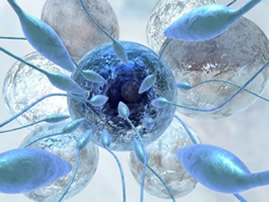 |
MALE INFERTILITY
Infertility affects about 20% of couples of reproductive age. This percentage has been rising over the recent years, due to environmental factors and social 'lifestyle' factors. Infertility affects both sexes and is attributable to the male partner in half the cases.
Several factors are responsible for the rising rate of male infertility.
Age
Infertility increases with the age of the male (>40 years).
It is associated with:
Reduced semen volume, reduced concentration (number), and motility, as well... |
| more |
| |
 |
FEMALE INFERTILITY
Female infertility may result from problems localized to the female genitalia or from systemic conditions. One of the most common causes are problems affecting the fallopian tubes, as well as ovulation disorders. Endometriosis, which is characterized by the development of endometrial tissue outside the uterus, affects 10% to 15% of women during their reproductive years; also, female fertility decreases with age. This decline begins after the age of 30, it becomes more evident after 35 and obviously more serious after 40; however, this does not mean that women do not conceive naturally at... |
| more |
| |
|
|
